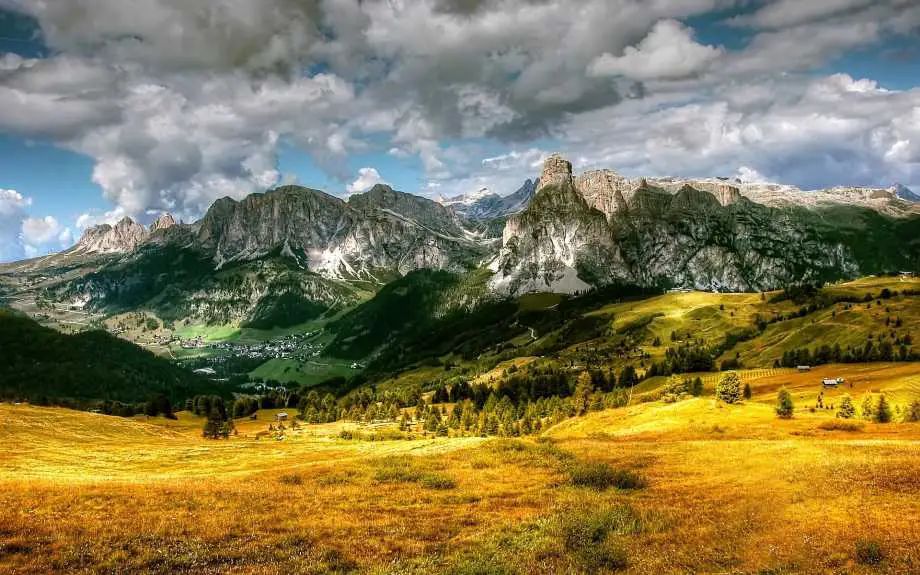The Alta Badia region in South Tyrol is rich in Alpine personality. Nearby lies Monte Marmolada, the highest peak and proclaimed ‘Queen’ of the Dolomites.
Alta Badia: An Overview
Alta Badia (Gadertal in German) is an area located in the region Trentino-Alto Adige, in Northern Italy. It is famed for its stunning natural landscapes, as it is set in the very heart of the Dolomites and surrounded on all sides by towering mountains and pretty Alpine valleys. In the region, visitors will discover six picturesque mountain villages, including La Villa and San Cassiano; which all share a quintessentially Tyrolean ambiance, not to mention plenty of places to eat and drink. The regional dialect is Ladin, though most locals speak Italian and German equally well.
It is a popular destination for hikers who enjoy particularly impressive scenery; as the area has an abundance of winding valleys, pine forests and huge mountain peaks. The sheer diversity of terrain also makes for appealingly varied hiking opportunities, and it is entirely possible to enjoy a challenging mountain walk one day, and a simple stroll through a rolling meadow the next.
Hikers seeking a real challenge will be drawn to Monte Marmolada, which is close to Alta Badia, and is the tallest peak in the Dolomites (3,343m/10,968ft). The huge peak, known locally as the ‘Queen of the Dolomites’, also boasts the only large glacier in the region. In 2009, the Dolomites officially became a UNESCO World Heritage site, and upon viewing the dramatic peaks and lush green valleys, it is easy to see why.
Although the area is popular with tourists, especially during the summer and winter months (for the walking and skiing, respectively), Alta Badia still maintains a strong sense of tranquillity. However, it manages to merge it seamlessly with plenty of available action and adventure!
Exploring the Alta Badia Area on Foot
The Alta Badia region has 400 kilometres (245 miles) of well-marked paths, leading through a wide variety of terrains. In the lower valley, there are plenty of gentle routes, through verdant fields and forests. There are also lots of challenging trails; some reaching to remote mountain huts (rifugi) and there are a number of ‘via ferrate’, routes which involve using ropes to climb across open rock faces.
There are also some fascinating history-themed walks in the region, such as the ‘Contourines Cave Bear’ route, which starts at San Cassiano and leads to a cave where ancient cave bear bones were discovered (7 hours, 2,800m/9,186ft) and Mount Lagazuoi, which was an important location during the 1st World War.
Things to Do in Alta Badia on a Rainy Day / Rest Day
Rock-climbing, as you might imagine, is a popular pastime in the region, and there are also plenty of cycle routes for those wishing to explore by bike. For an afternoon of entertainment up in the treetops, visit the High Ropes Course in Colfosco, which boasts 5 walkways and 71 platforms; the highest being 19 metres above ground.
Alta Badia is also home to two nature parks, Puez-Geisler and Fanes-Sennes-Prags, which are both prized due to their prolific varieties of rare plants, and impressive wildlife, including Golden Eagles.
In the villages, there is plenty of evidence of the Ladin culture, particularly in the handicrafts still practiced widely in the area, especially sculpture and weaving. The gastronomy of the region is also particularly excellent, and there are plenty of restaurants; including some Michelin starred establishments. Due to the unique local blend of cultures (Italian, Ladin and Tyrolean) visitors can enjoy a diverse, flavoursome range of cuisine; from the local Tyrolean pasta dishes, to the more Germanic-inspired schnitzels and strudels.
If faced with a rainy day, head to one of Alta Badia’s museums. The Museum Ladin Ursus Ladinicus has three floors of exhibits, full of information about the Dolomites, the famous Cave in the San Cassiano area and the lives of the cave bears that once resided there. Alternatively, the Museum Ladin Ciastel de Tor, set in an imposing castle-style building, focuses on the influences that helped shape the region and the culture of the Ladin people.
Things to Do in Alta Badia: Focus on Monte Marmolada
Monte Marmolada is a real highlight, and is surrounded by a series of other summits, including Sasso Beccè (2,535m/8,317ft), Col da Cuch (2,563m/8,409ft) and Sasso Capello (2,598m/8,524ft). Considerable experience is required in order to attempt to climb these peaks; however, there are plenty of easier walks in the near vicinity, and the scenery is absolutely breath-taking.
The site was particularly significant during the 1st World War, and formed part of the front line. To this day, as the glacier slowly retreats, discoveries are still occasionally being made of the remains of soldiers and their belongings.
How to Get to Alta Badia and Monte Marmolada
The Alta Badia region is mainly identified by the six villages within it, of which the liveliest and largest is Corvara. However, all of the villages have accommodation, restaurants and bars, and all provide a good base from which to explore the region.
Alta Badia is well served by several international airports within relatively close proximity, the most convenient of which is Innsbruck, which is approximately 2 hours’ drive away. Treviso and Milan airport are also options, although transfer times are around 3 hours. From the airport, it is possible to get a coach transfer to Alta Badia from most of the international airports.
There are many main roads surrounding Alta Badia, and as a result, it is relatively easy to get to the region if you’re driving.
Monte Marmolada and the surrounding peaks are fairly straightforward to reach, as they are surrounded by a ring-road, which is well linked to many of the main roads.

